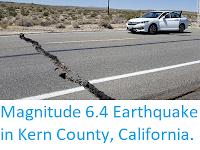The bodies of two climbers missing since Sunday 27 October 2019 were recovered from Red Slate Mountain, in the Sierra Nevada range of California, on Wednesday 30 October. Friends notified Mono County Search and Rescue when Jennifer Shedden, 34, of Mammoth Lakes, and Michelle Xue, 22, of Los Angeles, failed to return from a climbing trip on the mountain. The bodies of the two women were sighted in the in a couloir (narrow, steep-sided gully) on Monday by a California Highway Patrol helicopter. They were still attached to the rockface by ropes, and had apparently been killed by a rockfall, although rescuers were unable to recover them due to continuing instability on the rockface, with a second attempt by the National Guard failing the next day. The bodies were eventually retrieved by a Yosemite Search and Rescue helicopter. Both women are described as having been highly experienced climbers, and well equipped for the expedition.
A rescue team on Red Slate Mountain following the deaths of two climbers this week. Mono County Sheriff's Office.
Red Slate Mountain forms part of the Sierra Crest, a ridgeline that runs 800 km north-to-south through the Sierra Nevada Mountains, slightly to the south of the Long Valley Caldera. The mountain is not actually made of slate, but rather hornfels and marble, forms of mudstone and limestone that have been metamorphosed by heating and pressure. The area is seismically active; mountains appear to be permanent structures to humans, but are actually
dynamic active systems, being constantly uplifted (in the case of the
Sierra Nevada by the subduction of the last chunks of the ancient
Farallon Plate along the Pacific Coast of North America), and constantly
worn down by erosion, with the area around the Long Valley Caldera being particularly prone to movements. This combination of regular rock movements and a strong seasonal freeze-thaw cycle makes the area particularly prone to rockfalls (heating and cooling of the rock on a seasonal, or even daily, cycle,
causes the minerals to expand at different rates, leading to the
formation of cracks).
See also...
Follow Sciency Thoughts on Facebook.







